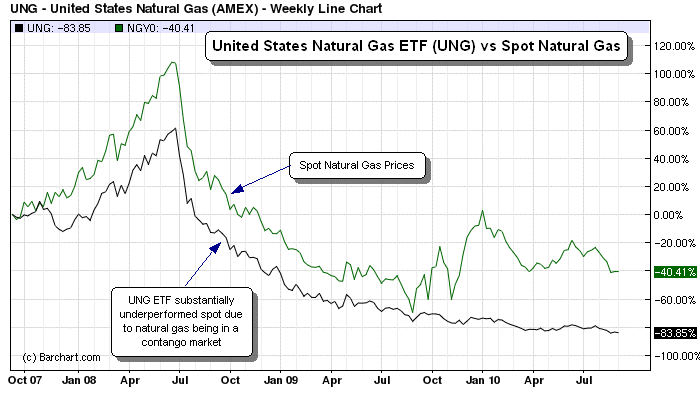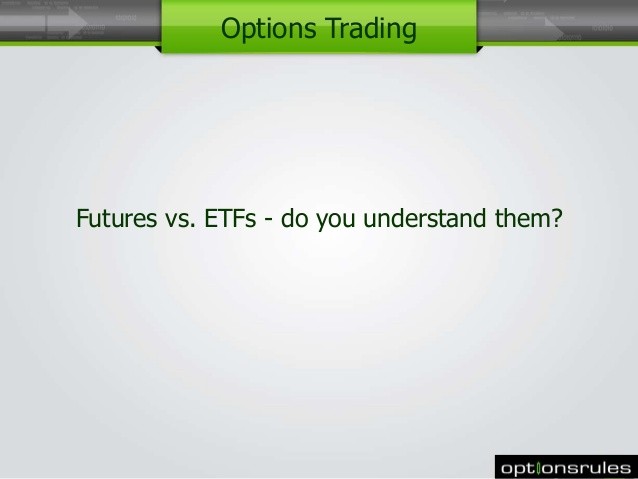Futures vs ETFs
Post on: 19 Апрель, 2015 No Comment

Smaller Trading Size = Greater Diversification
I am a great believer in diversification. I think it is an easy way to improve performance and some even think that:
The only free lunch available in financial markets is diversification.
Diversification presents the trader with the advantage of having to handle less downside heat, or alternatively, if he can handle the heat, he can upsize his portfolio and capture more profit for the same heat.
This last quote is an extract from Ed Seykotas page on diversification, with a simple demonstration of how diversification improves the results of 2 systems when combining them.
One problem with trading a diversified futures portfolio (50+ instruments) is the relatively high minimum account size because of the high notional size of the contracts. This is just for minimum account size. A larger account is usually more desirable, to enable more granular position sizing options (ie choosing between 1 to 10 contracts for example, instead of 1 or 0 or for scaling in/out of positions).
But diversification does not only involve the choice and number of instruments in the portfolio. You can diversify even more by trading multiple systems and multiple timeframes. This renders the required starting account size problem even worse Diversification is a free lunch only if you can afford the cover charge.
As a side note, I believe this is one of the reasons why managers like BlueTrend, who trade as a big fund (AUM in billions) are able to achieve their level of performance (18.71% CAGR with 12.56% MaxDD ).
A perfect illustration of the minimum lot difference can be found when looking at the S&P 500 index:
- The E-mini S&P 500 futures contract (ES) trades at around $55,000 (US$50 times the value of the S&P 500 stock index) for a margin requirement over $5,000.
- The corresponding Spyder ETF (SPY) is trading at just over $100
Trading ETFs can drastically lower the required account size for a system, allowing for a wide diversification by combining multiple systems on multiple timeframes on a large portfolio .
Range of instruments
There are now literally hundreds of ETFs, which would make trading a diversified portfolio using ETFs a real possibility. I have not yet taken the time to try and map a list of futures to their equivalent ETFs, but I suspect that a fair proportion of them would be available (and potentially more as illustrated by Lithium or Water ETFs). A good starting point for this would be the ETF database or similar (numerous) websites.
Of course the explosive growth of ETFs, including obscure ones, can create liquidity issues for the ETFs trading in thin markets. Not every ETF trades at $20B average daily volume (as is the case for SPY).
Another downside of trading with ETFs is their relative recency and lack of trading history (and therefore historical data available for back-test). This can be mitigated in most cases by using proxies in the form of corresponding instruments such as futures contracts but is obviously not as accurate as using the instruments themselves.
Operational Complexity / Roll-Overs
One of the characteristic of futures trading is the roll-over and choice between different available contracts. This is more complicated to handle (than your average stock for example) but allows for more fancy/interesting strategies .

ETFs, on the other hand, usually use futures as the underlying source of exposure. The mechanism for roll-over is handled by the ETF, which wrap the whole operation in one continuous security. The operational management of the roll-over is done for the investor. This however comes at a cost: direct (ETF fees) and indirect (lack of flexibility in approach).
There are also other issues with ETFs potentially impacting the futures markets (contango and backwardation rates) and suffering from their own market impact during roll-over periods (discussed here and here )
An ETF is a bit like outsourcing the futures roll-over process: it will not be as good as if you did it yourself but somebody else will save you the hassle of having to manage the process.
Lack of leverage and a Word on Volatility Decay
An obvious advantage of futures trading is the inherent leverage that it offers: for an initial margin of less than $10,000, you could control 1,000 barrels of crude oil (about $75,000 worth at the current price levels).
On the other hand ETFs trade very similarly to stocks and do not offer any sort of embedded leverage. Of course, as for any stock, you can trade on margin to add some leverage but this is never as high as the leverage on offer with futures and comes at a cost (broker margin rate).
There are of course leveraged ETF offerings (2x or 3x usually), but these suffer from another type of cost in the form of volatility decay. which make them less than ideal for longer holdings.
This is mainly due to the way the ETFs are rebalanced every day to replicate double or triple the rate of daily return. This can be illustrated by a very simple comparison example between an ETF and its leveraged counterpart.
Consider 2 daily returns of -10% and +11.11%. The standard ETF will end up unchanged ([1-0.1] x [1+0.1111] = 1) whereas a 3x leveraged ETF would end up losing 6.67% (([1 0.13] x [1 + 0.11113] = 0.93331).
This is a concept that has already been covered in this leverage post .
Closing Bell
I have noticed that the blogosphere has embraced ETFs in a very similar explosive fashion to the ETFs themselves. They do indeed offer an interesting alternative to futures trading and I will be looking more into it. I believe the main deciding point will be weighing up the additional diversification options from a much smaller minimum lot size versus their main downside: reduced leverage. Although this last point has been covered in A practical Guide to ETF Trading Systems .
Id be curious to hear what your experiences are on trading ETFs, so please share them via the comments section.














